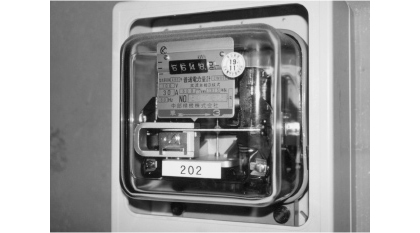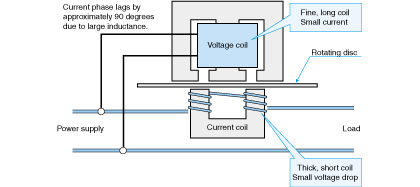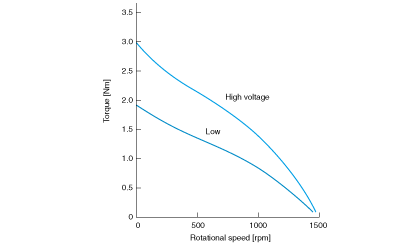2-3-4. Motor Using Arago's Disc




Now, what is Arago's disc (Fig. 2.42) that is frequently used for explaining AC motors?
The principle of Arago's disc goes that, when a disc made of copper or aluminum is sandwiched between magnets and the magnets are moved, eddy current is generated on the disc. And this eddy current causes the force that tries to move the disc in the moving direction of the magnets to be generated on the disc.
One of the familiar devices operating on this principle is the integrating wattmeter (induction electricity meter) (Fig. 2.43) installed on the leading wire at your home.
In the integrating wattmeter, a magnetic core of a coil made up of a large number of turns of a fine electric wire is installed on one side of an aluminum disc (Fig. 2.44). Even if the coil is parallel-connected to the lamp line, current consumption is very small because the electric wire is fine and long. This coil is called a voltage coil.
On the opposite side of the aluminum disc, another magnetic core of a coil made up of a small number of turns of a sufficiently thick electric wire is installed.
If you series-connect this coil to the lamp line, all current consumed at home flows via this coil.
However, the voltage drop is small since the coil wire is thick and short. This coil is called a current coil. The phase of current of these two coils is shifted by approximately 90 degrees due to the difference in inductance. So they generate a rotating magnetic field in the same way as the capacitor-run motor.
The eddy-current motor is one of the practical motors that utilize eddy current. As described in Chapter 1, a rotor primarily composed of soft steel is used for this motor. Movements of the magnetic field induce eddy currents in the rotor.
Eddy-current motors have characteristics as shown in Fig. 2.45. These motors provide the ability to control the torque by changing the applied voltage, and reduce torque pulsation, even when the motor shaft is restrained.
Because of these characteristics, eddy current motors are also called torque motors.
Due to these unique characteristics, torque motors are used in pressing mechanisms, braking systems, and winding units. However, since it is difficult for these motors to maintain rotating speed without a control mechanism, they are not appropriate for use as general power motors. Therefore, they are produced in limited volumes.


Three-phase AC
Electric power companies employ three-phase AC transmission and plants generally use three-phase AC power.
Why is three-phase transmission practiced?
Suppose you are transmitting three-phase electric power, the phases of which differ from each other by 120 degrees. Because each phase uses one outbound line and one return line, the total number of lines is six (three each for outbound and return).
Therefore, if you bundle the return lines, the number of lines is reduced to four (Fig. 2.46).
This is called the three-phase four-wire system. In this case, current I that flows through the return line is expressed as follows:
I = I0 {sinθ + sin(θ + 2/3π) + sin(θ - 2/3.π)}
If you calculate this, you will obtain 0. In other words, no current flows through the fourth line.
If no current flows, there is no need of a wire. Therefore, the fourth wire can be removed and three wires will be sufficient for transmission purposes.
This is called a three-phase three-wire system. As seen above, three-phase AC transmission is a rational wiring method that enables three wires to deliver the same quantity of electricity as six wires.